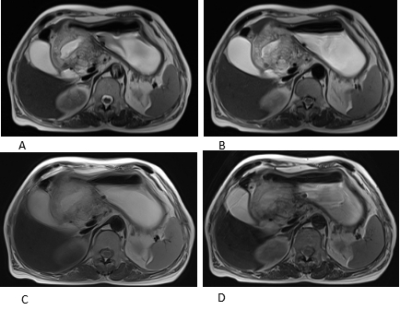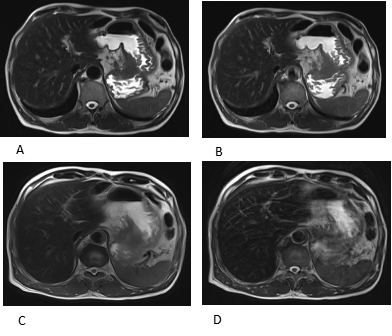Xiaosheng Xu1, Qinglei Shi2, Weishuai Wang3, Jia Wei4, Li Yang4, Qian Xu4, and Gaofeng Shi4
1The Fourth Hospital of Hebei Medical University, Shijiazhuang, China, 2MR Scientific Marketing,Siemens Healthcare, Beijing, China, 3MR Scientific Marketing,Siemens Healthcare, JINAN, China, 4The Fourth Hospital of Hebei Medical University, shijiazhuang, China
1The Fourth Hospital of Hebei Medical University, Shijiazhuang, China, 2MR Scientific Marketing,Siemens Healthcare, Beijing, China, 3MR Scientific Marketing,Siemens Healthcare, JINAN, China, 4The Fourth Hospital of Hebei Medical University, shijiazhuang, China
the HASTE sequence demonstrate good performance in gastric cancer diagnosis with much less motion artifacts and fast acquisition, which may help patients with poor respiratory curve or cannot hold breath

Fig 1, male, 56 years old with gastric cancer, (A) image acquired by TSE-HASTE with a subjective score of 5 points; (B) image acquired by conventional HASTE sequence sequence with a subjective score of 5 points; (C) image acquired by TSE- BLADE sequence with a subjective score of 3 points; (D) image acquired by conventional TSE sequence with a subjective score of 3 points.

Fig 2, male, 63 years old with gastric cancer with irregular breathing rhythm, (A) image acquired by TSE-HASTE with a subjective score of 5 points; (B) image acquired by conventional HASTE sequence sequence with a subjective score of 4 points; (C) image acquired by TSE- BLADE sequence with a subjective score of 2 points; (D) image acquired by conventional TSE sequence with a subjective score of 1 points.